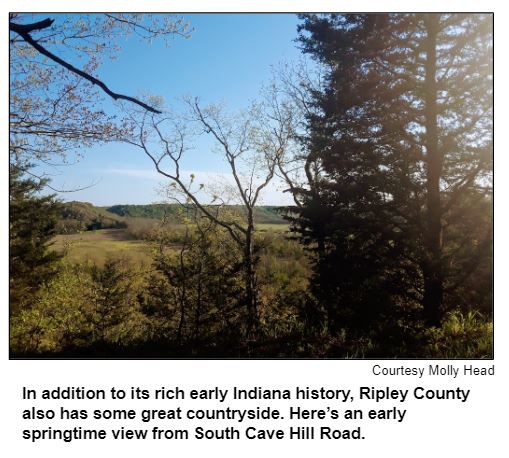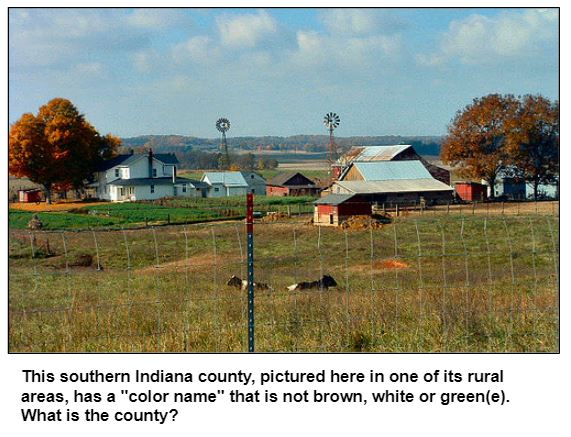
Saturdays, noon to 1 p.m. ET on WICR 88.7 FM.
Or stream audio live from anywhere on WICR Online!
You can listen to recent shows by clicking the podcast links below, or check out our extensive archive of past shows available as podcasts.
May 16, 2020
Where did your county's name come from?
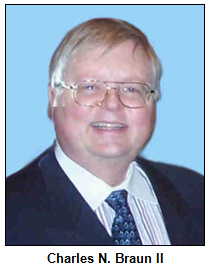 Two counties are named after Native American tribes. Many of Indiana's 92 counties have names that pay tribute to Revolutionary War heroes. And other county names salute famous Americans, including some who never set foot in the Hoosier state.
Two counties are named after Native American tribes. Many of Indiana's 92 counties have names that pay tribute to Revolutionary War heroes. And other county names salute famous Americans, including some who never set foot in the Hoosier state.
A few counties even are named after an aspect of their natural landscape. Lake County, with a northern border on the shores of Lake Michigan, is an obvious example.
For this show exploring the derivation of the names of Indiana's counties, Nelson will be joined by a WICR-FM colleague who has a passion for American history, including the origins of county names.
Charles Braun, the attorney who hosts Legally Speaking, the call-in legal advice show that airs at 11 a.m. on Saturdays, will be Nelson's guest. He's an admirer of French military hero Marquis de Lafayette (1757-1834) - and there's a direct connection involving our show's topic. Noting that Lafayette played a crucial role as an ally of the American colonists during the Revolutionary War, Charles points out that two counties have names that salute him.
Those two are Fayette County in eastern Indiana and LaGrange County, in the far-northeastern part of the state, which takes its name from Lafayette's French ancestral estate.
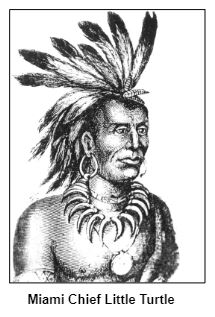
LaGrange County isn't the only one with a name connected to foreign soil. Switzerland County on the Ohio River is named in honor of the country that was the homeland of many of its early settlers.
Knox County, which includes Vincennes, Indiana's oldest city, is among those named after a notable American with no Hoosier connections. According to Indiana Place Names (IU Press) by Ronald Baker and Marvin Carmony, the county's namesake is Henry Knox, an artillery officer during the Revolutionary War who became the country's first Secretary of War. In that capacity, he oversaw both the Army and the Navy. Knox is immortalized in dozens of place names around the country, including the famous Fort Knox in neighboring Kentucky.
Delaware County, which includes Muncie, is derived from the name given by white settlers to the Lenape, the Native American tribe that lived along the East Coast before being pushed in the 1790s to the wilderness that became Indiana. The Lenape were called the Delaware by white settlers who encountered them in the East. Hoosier History Live explored the Lenape heritage in Indiana during a show in 2014.
Described by some experts as "the most moved group in American history," the Lenape were pushed out of Indiana during the early 1820s in what's been called a "forced migration."
Our guest Charles Braun is immersed in Indiana history in ways other than his knowledge of county names' origins. At the Benjamin Harrison Presidential Site in Indianapolis, Charles is the official reenactor of the only president elected from the Hoosier state. Charles has been hosting "Legally Speaking" for 37 years, making it the country's longest-running legal advice show with call-in from listeners.
Roadtrip: Versailles and Ripley County
Guest Roadtripper and travel and food writer Jane Ammeson of Michiana invites us on a trek to the town of Versailles and surrounding Ripley County in southeast Indiana.
Versailles has a rich history before and during the Civil War. In 1844, Indiana lawyer and abolitionist Stephen Harding delivered an anti-slavery speech on the Ripley County courthouse square in Versailles before an angry and armed group of pro-slavers.
During the Civil War era, Morgan's Raiders passed through Versailles, robbing the county treasury of $5000. The town is also said to have been a stopping place for freedom seekers during the time of the Underground Railroad.
A good first stop on our visit to Versailles: the Fernando G. Taylor House, which is on the National Register of Historic Places and is home to the Ripley County Tourism Office. Just across the street is the historic Ripley County Courthouse with its striking white clock tower.
Jane says we should be sure to check out the 6000-acre, wonderfully hilly Versailles State Park. One can't-miss feature: the Busching Covered Bridge. The 175-foot wooden span was built in 1885 over Laughery Creek. The park also boasts a 230-acre lake with rowboats, paddle boats and canoes available to rent.
There's much more to tell about this fascinating corner of Indiana, including a creepy legend about a Wolf Man - but we'll let Jane share those details when she takes us on this intriguing Roadtrip.
History Mystery
Indiana doesn't have a Red County or a Blue County, but several counties have names that correspond with colors. They include Brown County, White County and Greene County, although none of the names was derived from an association with the actual color. For example, Greene County in southwestern Indiana was named in honor of Nathaniel Greene, a Revolutionary War hero.
In addition to those mentioned above, there's another Hoosier county with a "color name," located in southern Indiana.
Question: What is the county in southern Indiana with a "color name," aside from those listed above?
The call-in number is (317) 788-3314. Please do not call in to the show until you hear Nelson pose the question on the air, and please do not try to win the prize if you have won any other prize on WICR during the last two months. You must be willing to give your name and address to our engineer and be willing to be placed on the air.
The prizes this week are two tickets to the Seiberling Mansion and a gift certificate to Windmill Grill, all in Kokomo, courtesy of Howard County Historical Society and Peggy Hollingsworth.
Preserving history for the future: Indiana Memory and Digital Public Library
For twelve years Hoosier History Live has been working hard to bring our listeners fascinating stories about the heritage of our beloved state, but we know that someday we ourselves will be a part of history. As an example, as many as 8% of the guests who have appeared on our show are now deceased. And many of our old shows are on CDs safely stored away, ready for digital archiving.
That's why we're so excited about our partnership with Indiana Memory and the Digital Public Library of America. Both projects seek to preserve and provide access to valuable primary sources that make up the culture and history of our state and the nation at large.
Working with the Indiana State Library we've begun uploading and cataloging digital files of our radio shows and weekly newsletters so that they can be available for research now and in the future.
And while we believe that this project is of great value, the cataloging and archival work that it requires is straining our already stretched budget.
Won't you consider making a donation to support our work on the Indiana Memory and DPLA projects? All you have to do is scroll up and hit the yellow "Donate" button.
That way, your grandchildren will be able to enjoy Hoosier History Live as much as you do.
Nelson Price, host and historian
Molly Head, producer/general manager, (317) 927-9101
Mick Armbruster, associate producer
Cheryl Lamb, administrative manager
Richard Sullivan, senior tech consultant
Pam Fraizer, graphic designer
Garry Chilluffo, consultant
Please tell our sponsors that you appreciate their support!

 For organizational sponsorship, which includes logos, links, and voiced credits in the show and in podcasts, contact producer Molly Head at (317) 927-9101 or email her at molly@hoosierhistorylive.org. Our podcast listens are increasing at a rate of 17% a month!
For organizational sponsorship, which includes logos, links, and voiced credits in the show and in podcasts, contact producer Molly Head at (317) 927-9101 or email her at molly@hoosierhistorylive.org. Our podcast listens are increasing at a rate of 17% a month!
Acknowledgments to Visit Indy, Fraizer Designs, WICR-FM, Henri Pensis, Aaron Duvall, Chloe Tyson, and many other individuals and organizations.
Thank you!
We'd like to thank the following recent, new and renewal contributors whose donations help make this show possible!
- Dr. Geoffrey Golembiewski
- Clark Kahlo
- Jim and Nancy Johnson
- Marion Wolen
- Robin Winston
- Peggy Hollingsworth
- Kathleen Angelone
- Jill Lough Chambers
- Jinsie Bingham
- Bruce and Julie Buchanan
- Jane Simon Ammeson
- Chuck and Karen Bragg
May 23, 2020 - coming up
Hoosiers who competed in early Indy 500s: encore
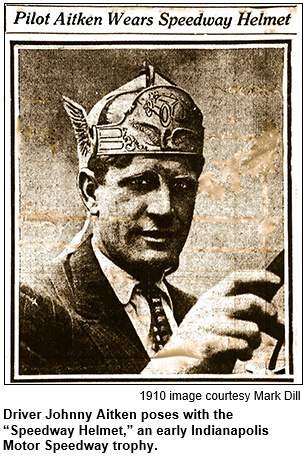 Even though there won't be an Indianapolis 500 this Memorial Day weekend due to the Coronavirus pandemic, we've got the green flag to explore the colorful heritage of the "greatest spectacle in racing." During this encore show originally broadcast in 2016, Hoosier History Live delves into the lives and careers of early race drivers who had deep connections to Indiana.
Even though there won't be an Indianapolis 500 this Memorial Day weekend due to the Coronavirus pandemic, we've got the green flag to explore the colorful heritage of the "greatest spectacle in racing." During this encore show originally broadcast in 2016, Hoosier History Live delves into the lives and careers of early race drivers who had deep connections to Indiana.
Here are some of the story nuggets involving "homegrown" competitors whose exploits captivated Indy 500 fans during the years immediately following the inaugural race in 1911:
- After 22-year-old native Hoosier Joe Dawson won the Indianapolis 500 in 1912, he hurried from the Indianapolis Motor Speedway to his family's home at 2828 N. Illinois St. to hug his mom.
- Charlie Merz, the son of an Indianapolis police officer, survived horrific accidents early in his racing career to complete the final lap of the Indy 500 in 1913 - with his car on fire. He died in 1952 and is buried in Crown Hill Cemetery.
- And in 1919, the Indy 500 was won by popular Howdy Wilcox, a pioneer race driver born in Crawfordsville. His son Howard S. Wilcox, also known as Howdy, founded the Little 500 bicycle race at Indiana University in the early 1950s.
Anecdotes about those race drivers and others with Hoosier connections are shared by our guest, Indy native and lifelong racing enthusiast Mark Dill, the creator of firstsuperspeedway.com, an extensive website about auto racing, including the sport's pre-1920 history.
Mark, who is based in Cary, N.C., has worked in marketing and public relations for various high-tech companies. He also previously worked for the Indianapolis Motor Speedway and, when he was an Indiana University student, as news director of Indianapolis Raceway Park. Mark and his wife Esther own Mark Dill Enterprises Inc., which helps market the rapidly growing sport of vintage auto racing.
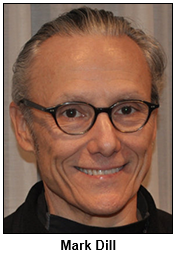 Speaking of vintage: Many Hoosiers know a bit about Ray Harroun, a Pennsylvania native who won the inaugural Indy 500 in 1911 with a Marmon car made in Indianapolis. That race has been the focus of Hoosier History Live shows, including some with Speedway historian extraordinaire Donald Davidson. Donald also was Nelson's studio guest on April 4, 2015 for a program that explored the impact of track announcer Tom Carnegie and popular driver Jimmy Clark, the "Flying Scot" who won the Indy 500 in 1965.
Speaking of vintage: Many Hoosiers know a bit about Ray Harroun, a Pennsylvania native who won the inaugural Indy 500 in 1911 with a Marmon car made in Indianapolis. That race has been the focus of Hoosier History Live shows, including some with Speedway historian extraordinaire Donald Davidson. Donald also was Nelson's studio guest on April 4, 2015 for a program that explored the impact of track announcer Tom Carnegie and popular driver Jimmy Clark, the "Flying Scot" who won the Indy 500 in 1965.
For this show, we explore some Hoosiers whose legacies are not as well remembered by the general public today - as well as others such as Wilcox and Barney Oldfield, an Ohio native who, as our guest Mark Dill puts it, was "embraced by Indiana like a native son." A confidant of Speedway founder Carl Fisher, Oldfield (1878-1946) was a racing pioneer and showman who even starred in silent movies.
Although Harroun won the inaugural Indy 500 in 1911, the first lap was led by driver Johnny Aitken, an Indianapolis native whose life and racing achievements Mark discusses during our show. (According to Donald Davidson's Official History of the Indianapolis 500 with co-author Rick Shaffer, Aitken stayed in front for the first four laps of the 1911 race.)
Mark also shares insights about Joe Dawson, the winner of the second Indy 500 who went home to hug his fretful mother, an anecdote celebrated in local newspapers in 1912. Described as a "simple, modest man," Dawson (at age 22 years and 10 months) remained the youngest Indy 500 winner for several decades.
According to Mark's research, Dawson lived with his parents in a house with "the 1912 version of a man cave" that featured college football and baseball pennants.
Other early Indy 500s drivers we will explore include "Farmer" Bill Endicott, whose nickname, Mark says, derived from his ownership of a farm near Crawfordsville.
 In addition to his website, Mark oversees a Facebook page on the same subjects.
In addition to his website, Mark oversees a Facebook page on the same subjects.
Earlier in his career, Mark was vice president of Nortel and, in that capacity, worked with former Indy 500 driver Scott Goodyear on sponsorships. Mark also is a regular guest and commentator about racing for radio and TV and has been active in the SportsCar Vintage Racing Association.
Before the inaugural Indy 500 in 1911, there were several other auto races at the Speedway after the track opened in 1909.
Some of these races were won by a talented young driver, Tommy Kincaid, who had been born in Indianapolis; he drove for the Indianapolis-based National Motor Vehicle Company race team owned by Arthur Newby. Our guest Mark Dill will share insights about Kincaid, even though he never raced in the Indy 500; that's because he was killed at age 23 at the Speedway in 1910 while testing his car. (If Tommy Kincaid had been alive in 1912, Mark suspects that he - rather than Joe Dawson, who hugged his mom after the victory - might have driven the winning car, which also was owned by National.)
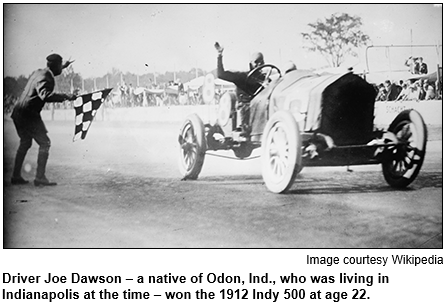 Barney Oldfield, who even starred in a Broadway musical, generally is considered to have been the first American auto racing celebrity. According to the website of the Henry Ford Archive of Innovation, Oldfield "helped to democratize not only racing entertainment, but also the automobile in general, as the vehicles moved out of the carriage houses and into backyard sheds."
Barney Oldfield, who even starred in a Broadway musical, generally is considered to have been the first American auto racing celebrity. According to the website of the Henry Ford Archive of Innovation, Oldfield "helped to democratize not only racing entertainment, but also the automobile in general, as the vehicles moved out of the carriage houses and into backyard sheds."
The website also notes that Oldfield "flouted the conventions of his time, both on and off the track. He was notorious for his post-race celebrations, womanizing and bar fights."
Charlie Merz, who finished the 1913 race with his car on fire, later became a successful businessman, engineer and chief steward of the Indy 500. According to a description of the 1913 Indy 500 on Mark's website, Merz's car burst into flames just before the final lap. Instead of stopping, he "forged ahead for the final lap ... with the riding mechanic swatting the flames with his jacket."
Learn more:
- Vanderbilt Cup Races - Author Howard Kroplick's website with information, images and events concerning the Vanderbilt Cup Races held on Long Island from 1904 to 1910.
- The Old Motor - A vintage-automobile "Internet magazine."
- Motor Sport Retro - A website that celebrates "classic motorsport, racing cars, motorcycles and gear."
- "The World When IMS Opened" - The Speedway's official website takes a look back at the year 1909.
- Donald Davidson on the Speedway's 100 years - Full audio (show length 26:27) from the March 5, 2011 Hoosier History Live interview with the Indianapolis Motor Speedway's track historian, Donald Davidson.
- Indianapolis Motor Speedway founder Carl Fisher's colorful life - Full audio (show length 29:42) from the May 16, 2009 Hoosier History Live show featuring Indianapolis historian Glory-June Greiff.
- Cruise-In.com - A website that celebrates Indiana car culture.
© 2020 Hoosier History Live. All rights reserved.
|






